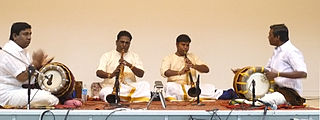- Nadaswaram
-
The nadaswaram, also spelt nadhaswaram, and also called nagaswaram (Tamil: நாதஸ்வரம்), is one of the most popular classical musical instruments in the South Indian culture and the world's loudest non-brass acoustic instrument[citation needed]. It is a wind instrument similar to the North Indian shehnai but larger, with a hardwood body and a large flaring bell made of wood or metal.
In South Indian Hindu culture, the nadaswaram is considered to be very auspicious, and it is a key musical instrument played in almost all Hindu weddings and temples of the South Indian tradition. It is part of the family of instruments known as a Mangala Vadya (lit. mangala : auspicious, vadya:instrument). The instrument is usually played in pairs, and accompanied by a pair of drums called thavil.
Contents
Construction
The nadaswaram contains three parts namely, kuzhal, thimiru, and anasu. Traditionally the body of the nadaswaram is made out of a tree called aacha.
It is a double reed instrument with a conical bore which gradually enlarges toward the lower end. It is usually made of a type of ebony. The top portion has a metal staple (called Mel Anaichu) into which is inserted a small metallic cylinder (called Kendai) which carries the mouthpiece made of reed. Besides spare reeds, a small ivory or horn needle is attached to the Nadaswaram. This needle is used to clear the reed of saliva and other debris and allows free passage of air. A metallic bell (called Keezh anaichu) forms the bottom end of the instrument.
The Nadaswaram has seven finger-holes. There are five additional holes drilled at the bottom which are used as controllers. The Nadaswaram has a range of two and a half octaves like the flute. The system of fingering is similar to that of the Indian flute. But unlike the flute where semi and quarter tones are produced by the partial opening and closing of the finger holes, in the Nadaswaram they are produced by adjusting the pressure and strength of the air-flow into the pipe. Hence it is a very exacting instrument. Also, due to its intense volume and strength it is basically an outdoor instrument and much more suited for open spaces than for closed indoor concert situations.
Artists
Some of the greatest early nadaswaramists [1] include Thiruvavadudurai Rajaratnam Pillai , Dr.Thiruvengadu Subramania Pillai , Sangita Kalanidi Thiruvizhimizhalai Subrahmanya Pillai , Thiruveezhimizhalai brothers , Keeranur brothers , Semponnarkoil brothers , Thiruvidaimaruthur P.S. Veerusami Pillai. In more recent times Dharumapuram A. Govindarajan, Namagiripettai Krishnan, Karukurichi Arunachalam, Sheik Chinna Moulana, Madurai brothers, Thiruvarur S Latchappa Pillai, Sheik Mahaboob Subhani and the Sembanarkovil Brothers (S R G Sambandam and S R G Rajanna) are well known.
U.S. composers such as Lewis Spratlan and Carl Stone have expressed admiration for the nadaswaram, and a few jazz musicians have taken up the instrument: Charlie Mariano (b. 1923) is one of the few non-Indians able to play the instrument, having studied it while living in India; and Rajesh Mehta, Vinny Golia, J. D. Parran, and William Parker have performed and recorded with the instrument. Tim Price, a student of Charlie Mariano at Berklee, also plays the nadaswaram. The German saxophonist Roland Schaeffer also plays it, having studied from 1981 to 1985 with Karupaia Pillai.
References
External links
- http://chandrakantha.com/articles/indian_music/nadaswaram.html
- http://www.kutcheribuzz.com/ebrochures/LatchappaPillai/
- http://www.nathaswaram.com
- http://sembanarkovilbrothers.com
Double reed instruments (also includes those with quadruple and sextuple reeds; does not include bagpipes) European classical
(modern)European classical
(historical)Aulos · Baroque oboe · Bassanelli · Cornamuse · Cromorne · Crumhorn · Dulcian · Hirtenschalmei · Kortholt · Oboe da caccia · Pommer · Rackett · Rauschpfeife · ShawmAfrican traditional Asian traditional Balaban/Duduk/Mey · Guan · Gyaling · Hichiriki · Hne · Kèn · Kèn bầu · Kèn đám ma · Kuzhal · Mizmar · Nadaswaram · Pi · Piri · Shehnai · Sundari · Sorna · Sralai · Suona · Taepyeongso · Zurna/SurnaiEuropean traditional American traditional Categories:- Carnatic music instruments
- Single oboes with conical bore
Wikimedia Foundation. 2010.

